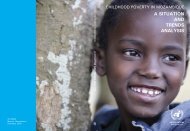English language version - Human Development Reports - United ...
English language version - Human Development Reports - United ...
English language version - Human Development Reports - United ...
- No tags were found...
Create successful ePaper yourself
Turn your PDF publications into a flip-book with our unique Google optimized e-Paper software.
Mozambique National <strong>Human</strong> <strong>Development</strong> Report 2007is the case of sexuality – meet with a carefully structuredtreatment, under particular criteria based onage, which symbolizes experience of life, and otherattributes that, in the individual charged with handlingthem, inspire confidence in others.Underlying this social experience is the conceptof sexuality and desire generally rooted in ideasabout the different roles of male and female identities,where the man is represented as strong andimpetuous, where the male drive and skill at dealingwith the world are synonyms with potency and virility,the opposite of women, transfigured into a suave,candid and fundamentally receptive femininity, underthe prism of sexual relations.Furthermore, in the social construction of sexuality,sexually transmitted diseases are traditionallyinterpreted as a transgression of sexual morality.These considerations, which are the basis forperceiving the motivations of sexual behaviour,escape the attention of the usual approaches of HIVand AIDS prevention efforts expressed in the nationalstrategies, which often err by basing themselves onstereotyped orientations of action (message) and ofreply (behavioural change), inspired in the biomedicaland behavioural understanding of sexuality andof reproductive health in general.The need for a deeper understanding of the determinantsof sex and sexuality is essential in order toseek out alternative and less conventional interventionsfor AIDS prevention. Indeed, it must be understood thatepidemics are, by definition, extraordinary events. Theyarise because the current understanding of health anddisease, and the prevailing health systems and institutions,are not able to cope with the particular form thatthey follow, and to staunch the particular mechanismsthrough which they are spread.Window of HopeAssuming that unprotected sex is the main route of HIVinfection in Mozambique, and considering that themedian age for first sexual relation is 16 years forwomen and 16.8 for men (IDS, 2003), the period thatprecedes these ages offers fertile ground for preventiveactions to curb the growing pace of HIV infection andreverse its pyramid among adolescents and youths.Even so, infection is possible, notably throughvertical transmission – that is the transmission of HIVfrom mother to child, among other abnormal events.Diagnosis and confirmation of HIV infection at anyage requires laboratory testing.Although there are other, more sophisticatedforms of laboratory diagnosis to detect HIV, viral particlesin body fluids, the diagnosis to confirm thepresence of the virus in the organism of a child bornto an HIV-positive mother, is undertaken as from the18th month, since that offers the best chance of interpretingwhether or not the virus is present in thechild (Patient and Orr, 2003).At birth, children possess maternal antibodiesfor various diseases, including HIV antibodies, butthis does not necessarily mean they are infected. Thematernal HIV antibodies decline gradually until theyare totally suppressed when the child is 18 monthsold. Definitive testing is advisable as from this age,since the antibodies detected then will indicate solelythe presence of HIV infection in the child (PTV,UNAIDS, 2003; Manual TTT. HIV Criança).Other signs and clinical symptoms of infection ofthe child by the HIV virus are used alternatively todetermine the situation and what should be done –for example, delayed growth and development,repeated opportunist infections, or persistent signsof malnutrition, among others.Following up the situation of child infections inthe first five years of life has shown that in manycountries, including Mozambique, children whocontract HIV through vertical transmission – duringpregnancy, birth or breast-feeding – have littlechance of surviving beyond their fifth or sixth birthday(PTV, UNAIDS, 2003; Manual TTT. HIVCriança).This fact, if it is not given due attention, may naturallycompromise the overall objectives of reducinginfant and maternal mortality rates, which have beenshowing signs of improvement (Government FiveYear Assessment 2000-2004). The reversal of theseindices of maternal and infant mortality associatedwith HIV and AIDS requires a more complete pictureof concrete activities to reduce HIV infection at allages, particularly after the first signs of the onset ofpuberty.In this context, the period from the 10th to the14th year of life is known as the Window of Hope.This is a period in which the HIV infection is certainlyabsent (apart from extraordinary or unusualsituations). The Window of Hope offers the bestprospects for educational and moral investment, formeasurable results in the future.The Window of Hope is so named because it isassumed that it offers an optimal entry point for pro-58
















